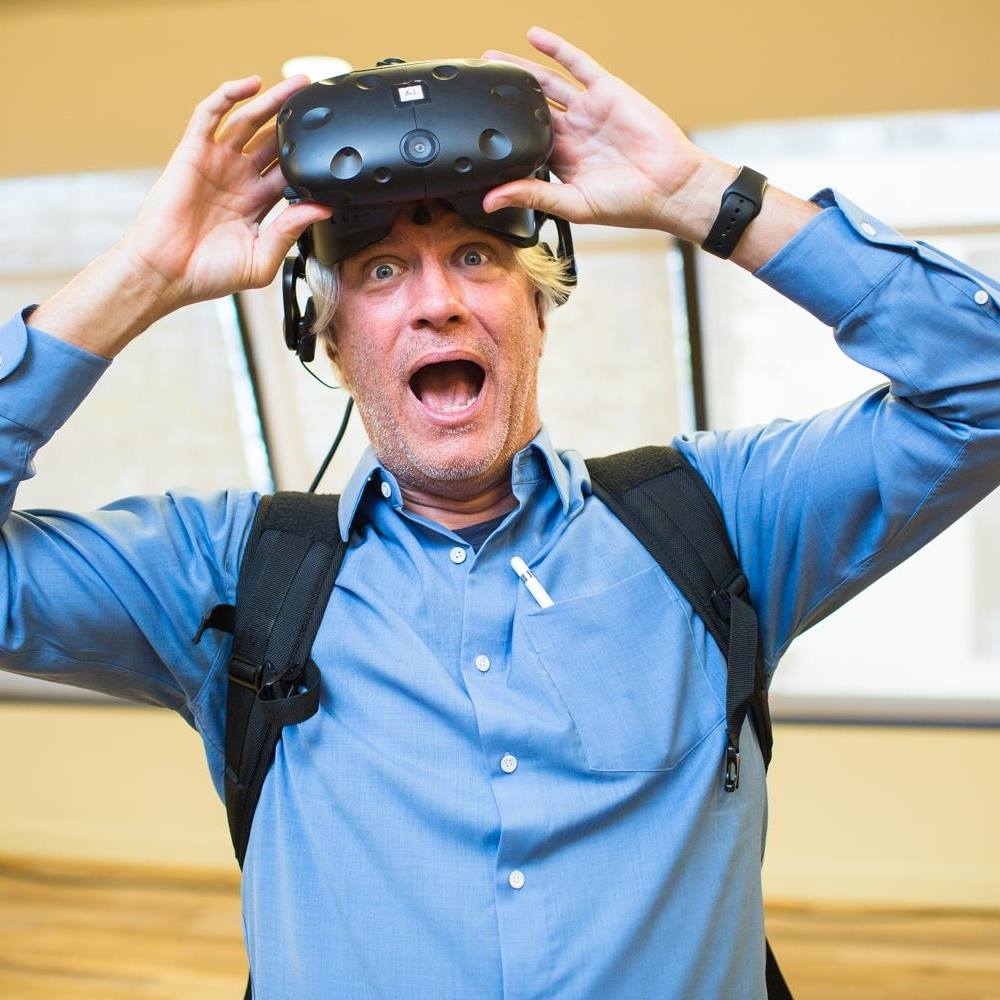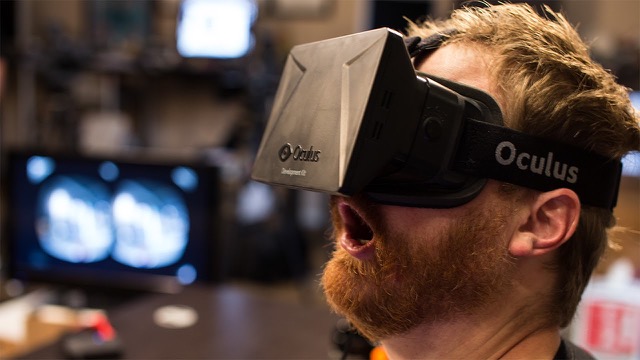
Bob Cooney
The VR Scene
Tech Development Bodes Well for Arcade-Based VR
by Bob Cooney
For the last two years, I’ve been observing the virtual reality market develop. In 2015, I went to IAAPA to research an article for this publication that was intended to proclaim that the third try at VR was not going to be a charm.
Instead, I experienced a handful of products that began to sway my opinion. I began to think that maybe, just maybe, the technology was catching up to the vision I had in 1992 when, with Edison Brothers Mall Entertainment, I opened a series of virtual reality/laser tag arcades in malls across America.

HTC Vive VR equipment.
Back then, the technology just didn’t cut it. The software lagged, the hardware was unreliable, cumbersome and really expensive, and many customers thought it was just plain weird. We rode the laser tag wave for almost a decade, but VR went into hibernation.
In the late ’90s, after a good run with Laser Storm, I joined Global VR in their startup stage. Their VR Vortek, when paired with the BeachHead 2000 PC game, was a hit, but we realized that VR was just a niche product.
During those early years, Global VR developed a core competancy of porting consumer PC games to arcade games, and leveraged that expertise to create more standard arcade games like EA Sports PGA Tour Golf and NASCAR from Electronic Arts that had a much larger addressable market.
And the second wave of VR crashed into the shore.
Fast forward almost 20 years and here we are again. But this time there is a huge difference. The development and promotion of VR has been driven by the consumer market. Huge technology companies like Facebook, Microsoft, HTC and Samsung, as well as startups with billions of dollars, are investing massive effort and money into developing virtual reality products. And it’s not just entertainment this time. VR is also making solid inroads in training, medical, architecture, engineering and other industries.

A user enjoys the virtual world within displayed through the Oculus headset.
The scale of the market opportunity is causing the cost of VR products to drop faster than any new technology in recent memory. HTC Vive and Facebook’s Oculus Rift have entered a price war that has seen prices for these flagship VR systems fall from $1,000 to $399 in a year. What hasn’t fallen, though, is the cost of the computing power needed to run them. But that could be changing.
The Vive and Oculus VR systems came with tracking cameras and remotes that enabled players to move within a room-sized environment and accurately project that movement in the virtual environment. It created an immersive experience that was beyond what most people had ever experienced. Suddenly, you could actually suspend your disbelief and enter into a game or a story, where previously you just watched through a fourth wall.
The downside of this tech is that it took a lot of room, and the setup was a pain (especially the Vive cameras which had to be mounted up high). But now we are seeing a new technology emerge called “inside-out tracking.” Using a combination of cameras mounted on the head-mounted display (HMD or headset) which “sense” what’s around you, and inertial measurement units (IMU) that measure how you are moving, these new products promise to track you in space without external cameras. It potentially reduces the cost of the technology and greatly increases the convenience.

Microsoft’s mixed reality reference design has found its way to products by Dell (upper left), Samsung (the Odyssey pictured above), HP (below) and Acer (lower left).
Microsoft recently unveiled its mixed reality design through licensed manufacturers like Acer, Dell, HP and Samsung. These headsets still need to be connected to an external computer, and my early tests of them have been less than convincing. But it’s very early and the tech will continue to improve. These sell for between $399 and $499 and include two hand controllers, which have LEDs embedded within to enable cameras to track them. It’s pretty cool to see your simulated hands in front of your face when you hold them.

Google Daydream and the other new headsets still cater to the low-end experience in which players are limited in their motion and immersion. Arcades can really step up their game and provide a unique, high-end experience for players.
Google is also in the race to develop inside-out, PC-free VR. Their Daydream Worldview platform has been licensed to HTC and Lenovo. HTC’s Vive standalone headset will be announced in November, (but as of this writing nothing yet is official…check out my VR Mentoring Facebook Group for more up-to-date info). The difference between the Vive Daydream headset is it won’t require a computer, or a cell phone. It’s all inside.
Oculus has been demonstrating early prototypes of an inside-out, wireless PC-free headset code-named Santa Cruz. It’s still “a few years away” according the Facebook VR Chief Hugo Barra, but it shows the direction the industry is heading. Oculus seems to be taking a more considered approach to VR, looking at the long view. When you make $5 billion in profit per quarter on $10 billion in sales you can afford to.
All of these platforms seem to be targeted to lower-end VR experiences versus the high-end gaming market that Oculus and HTC currently enable. The benefit will be you can play them almost anywhere. You could have it sitting on the coffee table, grab it and be gaming in minutes. This is one of the main barriers to adoption of VR today: It’s a process to play. And when people want to play, they don’t want to hassle with stuff.

Hologate’s multi-player, room-scale VR.
Remember all those cool race-car tracks we had as kids. Or the model trains. Once we set them up, we wanted to keep them that way until our parents yelled at us that we were dominating the dining room table. Then we’d find a way to slide them under our bed so we could play whenever we want without the investment in setup. That’s what the room-scale VR systems are like today.

Virtuix’s Omni compact virtual reality motion platform.
All of this is setting up to really benefit the arcade business. The majority of home VR systems are going to be lower-resolution, lower-powered devices that track very limited mobility. This creates plenty of room for the arcade industry to offer unique, social and higher fidelity experiences that people will flock to. Whether that’s large-scale, free-roam VR like Zero Latency or VR Studios, or the new multiplayer room-scale systems like Hologate or Virtuix Omni (available in as the Omni Arena from UNIS), there seems to be plenty of room in both the short and intermediate term to dive into the VR pool.
If all of this is of interest to you, I invite you to join my VR arcade mentoring group on Facebook. You’ll find all the latest news, product reviews and research on location-based VR. You can ask questions, and get replies from the leaders in the VR industry. You’ll find a link from my homepage at www.bobcooney.com. Use the code RePlay for a free 90-day trial.
Electronic gaming and location-based entertainment veteran (and avid surfer) Bob Cooney has 25-years of experience designing, manufacturing and marketing out-of-home entertainment to consumers, operators and venues –– first as founder and chief executive of NASDAQ- and Inc. 500-listed Laser Storm, and later as an initial member of the Global VR executive team which introduced the first commercially viable virtual reality arcade game. Cooney went on to become VP of marketing and business development of Ecast, the digital content provider for jukeboxes, and COO of NTN Buzztime, the networked trivia game company. Cooney has been a driving force behind the development of numerous top-earning licensed games, including products based on EA Sports PGA Tour, X-MEN and Stargate, and has been a long-time vocal proponent of leveraging new technology to keep the out-of-home amusement industry relevant. Bob consults with companies on strategy and business development, and currently serves as a business development consultant to Zero Latency. He can be reached at www.bobcooney.com.




1 Comment
Pingback: The VR Scene - Bob Cooney